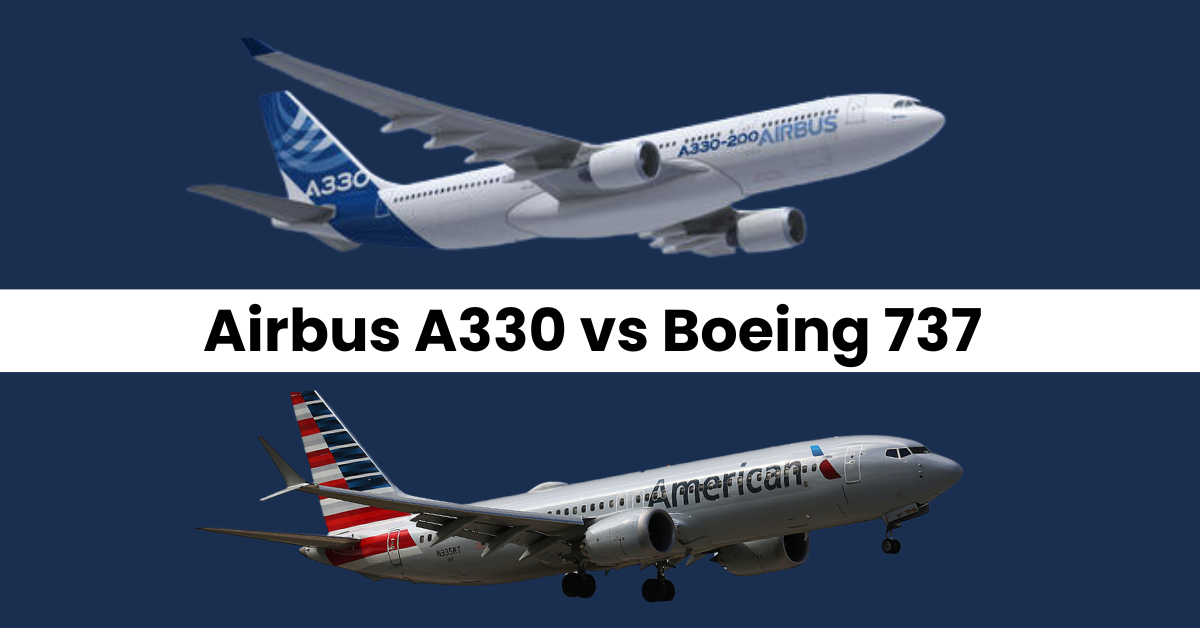The Airbus A330 vs Boeing 737 stand as titans in the aviation world, each carved out for specific skies. The A330, with its wide wings and spacious cabin, is the go-to for long journeys, offering comfort and cargo space for international travel. The 737, nimble and efficient, navigates short to medium routes with ease, making it a favorite for quick hops between cities. This comparison dives into the heart of what makes each model unique, shedding light on their roles in connecting the world.
Airbus A330 vs Boeing 737

The Airbus A330 vs Boeing 737 serve different market segments within the aviation industry. The A330-300, with its wide-body design, is tailored for long-haul, international flights, offering a larger capacity, longer range, and higher service ceiling. It’s suitable for airlines looking to transport a significant number of passengers across continents comfortably. On the other hand, the Boeing 737-800, a narrow-body aircraft, excels in short to medium-haul flights. It’s prized for its efficiency, lower operating costs, and ability to operate in smaller airports, making it a favorite for domestic and regional services. The choice between the two ultimately depends on the specific needs of an airline’s route structure and passenger demand.
| Specification | Airbus A330-300 | Boeing 757-300 |
|---|---|---|
| Country of Origin | France | United States |
| Manufacture Period | 1993 – Present | 1998 – 2004 |
| Price (USD) | $264.2 million | $80 million |
| Avionics | Rockwell Collins | Rockwell Collins |
| Engines | 2 X General Electric CF6 | 2x Rolls-Royce RB211-535E4/B or Pratt & Whitney PW2000-40/43 |
| Engine Power (pound-force) | 71,100 | 43,500 |
| Max Cruise Speed (knots/Km/h) | 470 / 870 | 496 / 919 |
| Travel Range (Nautical Miles/Kilometers) | 6,350 / 11,760 | 3,467 / 6,421 |
| Fuel Economy (nautical mile/gallon) | 0.26 / 0.127 km/l | 0.3 / 0.147 km/l |
| Service Ceiling (feet) | 41,100 | 42,000 |
| Take Off Distance (meter/feet) | 2770 / 9,087.82 | 2600 / 8,530.08 |
| Landing Distance (meter/feet) | 1730 / 5,675.78 | 1550 / 5,085.24 |
| Max Take Off Weight (Kg/lbs) | 242,000 / 533,513 | 123,830 / 272,996 |
| Max Payload (Kg/lbs) | 45,900 / 101,191 | 30,940 / 68,210 |
| Fuel Tank Capacity (gallon/litre) | 36,744 / 139,091 | 11,490 / 43,494 |
| Baggage Volume (m³/ft³) | 158.4 / 5,594 | 67.5 / 2,384 |
| Seats – Economy | 335 | 295 |
| Cabin Dimensions (Height x Width x Length) | 2.54m x 5.28m x 50.35m / 8.33ft x 17.32ft x 165.19ft | 2.13m x 3.54m x 43.21m / 6.99ft x 11.61ft x 141.76ft |
| Exterior Length | 63.6m / 208.66ft | 54.43m / 178.57ft |
| Wing Span | 60.3m / 197.83ft | 38.06m / 124.87ft |
Airbus A330
The Airbus A330 is a wide-body aircraft that has been a part of the aviation world since 1993, known for its versatility and efficiency on medium to long-haul flights. Manufactured by Airbus in France, it has a price tag of around $264.2 million. Equipped with Rockwell Collins Avionics and powered by two General Electric CF6 engines, the A330 can produce a thrust of 71,100 pound-force, allowing it to cruise at a speed of 470 knots over a range of 6,350 nautical miles. Its excellent fuel economy of 0.26 nautical miles per gallon and a service ceiling of 41,100 feet make it a preferred choice for airlines globally. The A330-300 variant, capable of seating up to 335 economy class passengers, combines comfort with performance, offering a spacious cabin and significant payload capacity, making it ideal for a variety of routes and destinations.

Boeing 737
The Boeing 737, recognized as the best-selling commercial jetliner in history, first took to the skies in 1967 and has since become a staple in the fleets of airlines worldwide. Designed and manufactured by Boeing in the United States, this narrow-body aircraft is celebrated for its reliability, fuel efficiency, and versatility across a range of short to medium-haul routes. The 737 series has evolved through several generations, including the Classic, Next-Generation, and the latest MAX variants, each offering improvements in fuel economy, passenger comfort, and technological advancements. With configurations that can accommodate between 85 to 215 passengers, the 737 is adept at serving everything from low-demand routes to high-density flights. Its design, featuring a single aisle and two engines, strikes an optimal balance between operational cost-effectiveness and passenger experience, making it a favored choice for airlines seeking to maintain competitive services on domestic and international flights.

Airbus A330 vs Boeing 737 Size And Capacity
When comparing the Airbus A330 vs Boeing 737 Size, their differences in size and capacity are quite significant, reflecting their distinct roles in aviation. The Airbus A330, a wide-body aircraft, is substantially larger and designed for long-haul flights. It can comfortably accommodate around 250 to 440 passengers, depending on the configuration, offering more space and amenities for international travel. With a length of approximately 63.6 meters and a wingspan of about 60.3 meters, the A330 provides ample cabin space for passengers and cargo alike.
On the other hand, the Boeing 737, particularly the Next-Generation and MAX variants, is a narrow-body aircraft favored for short to medium-haul routes. It typically seats between 85 to 215 passengers, making it less spacious but highly efficient for frequent, regional services. The 737’s length ranges from about 33 to 43 meters, with a wingspan near 35.8 meters for the Next-Generation models, and slightly more for the MAX variants due to their extended wingtips.
Here’s a comparison table summarizing their sizes and capacities:
| Feature | Airbus A330 | Boeing 737 |
|---|---|---|
| Body Type | Wide-body | Narrow-body |
| Passenger Capacity | 250-440 | 85-215 |
| Cabin Width | 5.28 meters (17.32 feet) | 3.54 meters (11.61 feet) |
| Length | 63.6 meters (208.66 feet) | 30-42 meters (98-138 feet) depending on variant |
| Wingspan | 60.3 meters (197.83 feet) | 28.9-35.8 meters (95-117 feet) depending on variant |
| Height | 16.79 meters (55.1 feet) | 11.3-12.5 meters (37-41 feet) depending on variant |
| Typical Range | 5,000-8,300 nautical miles | 2,935-3,850 nautical miles depending on variant |
In summary, the Airbus A330’s larger size and higher passenger capacity make it ideal for airlines operating long-distance routes requiring comfort and cargo space. In contrast, the Boeing 737’s smaller dimensions and lower capacity suit short to medium-distance flights, prioritizing efficiency and operational cost savings.
Airbus A330 vs Boeing 737 Comfort & Design
In terms of passenger comfort, the Airbus A330 outshines the Boeing 737, primarily due to its wide-body design that offers more space and amenities suited for long-haul flights. The A330’s cabin is designed to provide passengers with enhanced comfort features such as wider seats, more legroom, and larger aisles. This spacious environment allows for higher comfort levels, especially in premium classes where passengers can enjoy lie-flat beds. Additionally, the larger cabin facilitates a quieter, more relaxed atmosphere, further improving the travel experience on longer journeys.
The Boeing 737, while efficient and well-designed for its role in short to medium-haul routes, has a narrower cabin due to its narrow-body configuration. This limits the space available for passenger seats and aisles. Despite modern improvements like redesigned overhead bins for increased storage and larger windows for a more spacious feel, the 737’s focus remains on maximizing efficiency and capacity, which naturally constrains its ability to match the A330’s comfort levels on longer flights.



So, when it comes to being comfortable, especially on long flights where having more room and better features matters a lot, the Airbus A330 Clearly beats the Boeing 737. The A330 is made to give you more space, like wider seats and more room to stretch your legs, making it great for long trips across countries. The 737 is a good plane for shorter trips, focusing more on being efficient and fitting as many passengers as possible. It doesn’t offer the same level of comfort as the A330 does for longer journeys.
Airbus A330 vs Boeing 737 Engines
When comparing the engines and fuel efficiency of the Airbus A330 vs Boeing 737, there are some key differences to note, largely due to their different sizes and intended uses. The A330’s engines are more powerful, supporting its role as a long-haul carrier with fewer refueling stops, while the 737’s engines focus on fuel efficiency and cost-effectiveness for shorter flights.
Airbus A330 Engine
The Airbus A330 is typically powered by two General Electric CF6 engines, each capable of producing up to 71,100 pound-force of thrust. This powerful engine setup enables the A330 to cover long distances efficiently, with a fuel economy that allows it to travel about 0.26 nautical miles per gallon. Its large fuel tank capacity supports extended ranges, making it well-suited for long-haul flights without the need for frequent refueling.
Boeing 737 Engine
In contrast, the Boeing 737, specifically models like the 737-800, uses two CFM International CFM56-7B engines, each providing up to 27,300 pound-force of thrust. While these engines are less powerful than those of the A330, they are incredibly efficient for the 737’s size and mission profile. The 737 boasts a better fuel economy, achieving approximately 0.44 nautical miles per gallon, thanks to its lighter weight and optimized aerodynamics. This efficiency, combined with a smaller fuel tank, makes the 737 ideal for short to medium-haul routes where frequent refueling is more manageable and less of a concern.
Airbus A330 vs Boeing 737 Pricing
The Airbus A330 vs Boeing 737 come with different price tags, reflecting their distinct capabilities and market positions. The Airbus A330, a larger, wide-body aircraft designed for long-haul flights, has a price of approximately $264.2 million. This cost is justified by its extensive range, advanced avionics, and spacious cabin, catering to airlines’ needs for international travel.
On the other hand, the Boeing 737, particularly favored for short to medium-haul routes due to its efficiency and narrow-body design, is priced at around $89.2 million for the 737-800 variant. This lower price makes the 737 an attractive option for airlines focusing on domestic and regional services, offering a cost-effective solution for high-frequency operations. In summary, the A330’s higher price reflects its larger size and longer range capabilities, while the 737’s more affordable cost aligns with its role in shorter, more frequent flights.
Conclusion
The Airbus A330 vs Boeing 737 cater to different segments of the aviation market, each with its strengths. The A330’s wide-body design and long-range capabilities make it a top choice for international long-haul flights, offering superior comfort and large cargo space, justified by its higher price. Meanwhile, the 737’s narrow-body, efficient design is suited for short to medium routes, favored by airlines for its cost-effectiveness and versatility in domestic and regional operations. The decision between the A330 and 737 ultimately depends on the airline’s specific needs and goals, as both aircraft play pivotal roles in connecting the world through their distinct advantages.
FaQs
Why is the Airbus A330 more expensive than the Boeing 737?
Can the Boeing 737 be used for long-haul flights?
Can the Airbus A330 carry more passengers than the Boeing 737?
How do airlines decide between purchasing an Airbus A330 vs Boeing 737?
Which aircraft is better for airlines focusing on domestic routes?



